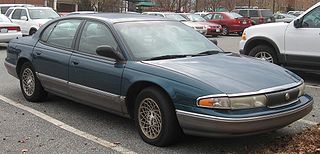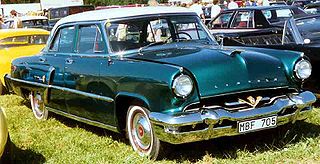
The Chrysler New Yorker is an automobile model that was produced by Chrysler from 1940 until 1996, serving for several decades as either the brand's flagship model or as a junior sedan to the Chrysler Imperial, the latter during the years in which the Imperial name was used within the Chrysler lineup rather than as a standalone brand.

The Oldsmobile Series 70 is a full-size midrange automobile produced by Oldsmobile between the 1939 and 1950 model years. Oldsmobiles of this time period were in an unusual "middle" position in GM's hierarchy of automobile brands. Chevrolet and Pontiac were the budget priced models, while Buick and Cadillac were the luxury brands. GM would share their "A" body platforms between Chevrolet, Pontiac, and "B" body on Oldsmobile and Buick, while leaving Cadillac on the senior "C" platform. Oldsmobiles were then branded as "luxury level" Chevrolet's and Pontiac's, while Oldsmobiles using the "B" platform were "budget priced" Buicks and Cadillacs.

The Cadillac Calais is an automobile that was the entry-level Cadillac model that was sold from 1965 to 1976. Cadillac renamed its low-priced Series 62 in 1965 as the "Calais", after the French port city of Calais that overlooks the narrowest point in the English Channel. In Greek mythology, Calais was one of two winged sons of Boreas, god of the North Wind, and Oreithyea. With the exception of no convertible model, the Calais shared the same styling and mechanics as the better-equipped, more expensive Cadillac de Ville.

The Pontiac Ventura is an automobile model which was produced by Pontiac between 1960 and 1977.

The Mercury Montclair is a series of full-size sedans that were manufactured and marketed over five generations by the Mercury division of Ford. The nameplate was used by the division twice, from the 1955 to the 1960 model years and from the 1964 to the 1968 model years. The model was offered as two-door and four-door hardtops, four-door pillared sedan, and a two-door convertible.

The Mercury Park Lane is a full-sized automobile that was produced by the Mercury division of Ford Motor Company. While not officially introduced as the replacement of the Mercury Turnpike Cruiser, the Park Lane became the flagship of the Mercury model line upon its introduction. The second-generation Park Lane was positioned above the Mercury Montclair.

The Cadillac Series 40-62 is a series of cars which was produced by Cadillac from 1940 through 1964. Originally designed to complement the entry level Series 61, it became the Cadillac Series 6200 in 1959, and remained that until it was renamed to Cadillac Calais for the 1965 model year. The Series 62 was also marketed as the Sixty-Two and the Series Sixty-Two. The Series 62 was used to introduce the Cadillac Coupe de Ville and the Cadillac Eldorado which started out as special appearance packages that were later placed into production.

The Mercury Colony Park is an American luxury full-size station wagon that was marketed by the Mercury division of Ford Motor Company between 1957 and 1991. Distinguished by its simulated wood-grain paneling, the Colony Park was marketed as either the premium-trim or the sole full-size station wagon offering of the division. Following the 1960 demise of Edsel, full-size Mercury vehicles shared bodywork with Ford; the Colony Park served as the counterpart of the Ford Country Squire through 1991.

The Mercury Meteor is an automobile that was produced by Mercury from the 1961 to 1963 model years. Adopting its nameplate from the namesake Ford of Canada brand, the Meteor was introduced as the base-trim full-size Mercury sedan, while the compact Mercury Comet shared a naming convention associated with the ongoing Space Race of the early 1960s. Slotted below the Mercury Monterey, the Meteor was the Mercury counterpart of the Ford Fairlane.

The Lincoln Cosmopolitan is a full-size luxury car that was sold by Lincoln from the 1949 through the 1954 model year. All Lincolns were manufactured at Lincoln Assembly, Dearborn, Michigan, while some were sent in "knock-down kits" to regional factories at Maywood Assembly, Maywood, California or St. Louis Assembly, St.Louis, Missouri, and assembled locally.

The Lincoln Premiere was a luxury car model sold by Lincoln in the 1956 to 1960 model years. Positioned below the company's Continental Mark II coupe during 1956–1957 and above the Capri which it shared from 1956 to 1959, it was produced in 2 and 4 door versions which could both accommodate up to six people.

The Lincoln Capri is an automobile that was sold by the Lincoln division of Ford Motor Company from 1952 until 1959. A full-size luxury car, the Lincoln Capri derives its name from an Italian island in the Gulf of Naples. Introduced as a premium trim variant of the two-door Lincoln Cosmopolitan, the Capri was introduced in 1952 as a stand-alone model line serving as the premium Lincoln. With the introduction of the Lincoln Premiere, the Capri replaced the Cosmopolitan as the standard Lincoln product line.

The Packard Patrician is an automobile which was built by the Packard Motor Car Company of Detroit, Michigan, from model years 1951 through 1956. During its six years in production, the Patrician was built in Packard's Detroit facilities on East Grand Boulevard. The word "patrician" is Latin for a ruling class in Ancient Rome. It was the last "senior level" Packard until production ended in 1958.

The Packard 200 was an automobile model produced by the Packard Motor Car Company of Detroit, Michigan during model years 1951 and 1952. Models in the 200 designation represented the least expensive Packard model range, on the firm's shortest wheelbase, and least powerful 288 cu in (4.7 L) 8-cylinder in-line engine. It replaced the Packard One-Twenty and the Packard One-Ten, and was renamed the Packard Clipper for the 1953 model year.

The Packard Caribbean is a full-sized luxury car that was made by the Packard Motor Car Company of Detroit, Michigan, during model years 1953 through 1956. Some of the Caribbean's styling was derived from the Pan American Packard show car of the previous year. Available only as a convertible from 1953 until 1955 with a hardtop model added in its final year of 1956.

The Mercury Monterey is a series of full-size cars that were manufactured and marketed by the Mercury division of Ford from 1950 to 1974. Deriving its name from Monterey Bay, the initial Mercury Monterey served as the top-of-the-line two-door sedan model for 1950 and 1951 to compete with the hardtop models of Oldsmobile and Buick. It came with a vinyl roof covering, upgraded upholstery, and other features. The hardtop was introduced for 1952. During its production, the Monterey would be offered in multiple body styles, ranging from coupes, convertibles, sedans, hardtops, and station wagons.

The Buick Super is a full-sized automobile produced by Buick from 1940 through the 1958 model years, with a brief hiatus from 1943 through 1945. The first generation shared the longer wheelbase with the top level Roadmaster while offering the smaller displacement engine from the Buick Special. The Super prioritized passenger comfort over engine performance. For several years, it was called the "Buick Eight" or "Super Eight" due to the engravement on the grille while all Buick's since 1931 were all installed with the Buick Straight-8 engine with varying engine displacement.

The name Mayfair was applied to the 1951-53 Packard 250 as a hardtop coupe nameplate built by the Packard Motor Corporation in an attempt to compete in this body style with the Oldsmobile 98 Holiday, Buick Roadmaster Riviera, Lincoln Capri and Chrysler New Yorker Newport hardtop coupes. It was named for the City of Westminster's luxurious district Mayfair in London, England. The coupe body style was also used for a convertible, while the Mayfair model name was exclusive to the hardtop.

The Packard Pacific is an automobile manufactured by the Packard Motor Car Company of Detroit, Michigan for the 1954 model year. It replaced the Mayfair and was sold exclusively as a two-door hardtop.

The Mercury Custom is an automobile which was produced by Mercury for the 1952 through 1956 model years.






















